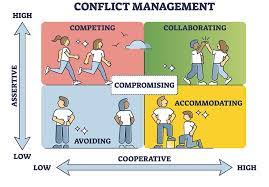Introduction
Conflict is a natural part of human interaction, and it can arise in various contexts, such as relationships, workplaces, and communities. Conflict management is a process that involves identifying, addressing, and resolving conflicts in a constructive manner. Effective conflict management can enhance relationships, foster collaboration, and promote growth and learning.
In this blog, we will explore the key concepts and strategies of conflict management, including types of conflict, conflict resolution styles, communication techniques, and conflict prevention.
Types of Conflict
Conflict can take many forms, and it can stem from various sources, including differences in values, beliefs, opinions, interests, and goals. Here are some common types of conflict:
Personal conflict: This type of conflict arises from interpersonal issues, such as personality clashes, communication problems, and past grievances.
Organizational conflict: This type of conflict occurs within or between organizations, such as disagreements over goals, resources, policies, and procedures.
Intergroup conflict: This type of conflict arises between different groups, such as ethnic, cultural, or religious groups, and it can lead to discrimination, prejudice, and violence.
Intrapersonal conflict: This type of conflict is internal, and it arises from conflicting values, desires, or emotions, such as when someone is torn between two choices or faces a moral dilemma.
Conflict Resolution Styles
When faced with a conflict, individuals and groups can adopt different styles of conflict resolution, depending on their personalities, values, and goals. Here are some common conflict resolution styles:
Collaborating: This style involves working together to find a mutually beneficial solution that satisfies the needs and interests of all parties. It requires open communication, active listening, and creative problem-solving.
Competing: This style involves pursuing one’s own interests and goals at the expense of others. It can lead to win-lose outcomes, resentment, and hostility.
Compromising: This style involves finding a middle ground or a partial solution that partially satisfies the needs and interests of all parties. It can be useful when time and resources are limited, but it may not address the underlying issues.
Avoiding: This style involves ignoring or withdrawing from the conflict, hoping that it will go away or resolve itself. It can be useful in certain situations, such as when the stakes are low, but it can also lead to unresolved issues and simmering tensions.
Accommodating: This style involves sacrificing one’s own interests and goals to accommodate the needs and interests of others. It can be useful when preserving relationships is more important than achieving personal goals, but it can also lead to resentment and loss of self-esteem.
Communication Techniques
Effective communication is essential for resolving conflicts and preventing misunderstandings. Here are some communication techniques that can enhance conflict management:
Active listening: This involves paying attention to the other person’s words, tone, and body language, and seeking to understand their perspective and feelings.
Empathy: This involves putting oneself in the other person’s shoes and imagining how they feel and think.
Clarification: This involves asking questions, restating the other person’s words, and seeking clarification to avoid misunderstandings.
I-messages: This involves expressing one’s feelings, thoughts, and needs in a non-judgmental and assertive way, using “I” statements instead of “you” statements.
Conflict de-escalation: This involves reducing the emotional intensity of the conflict by using calming words, gestures, and behaviors, such as deep breathing, lowering the voice, and using humor.




